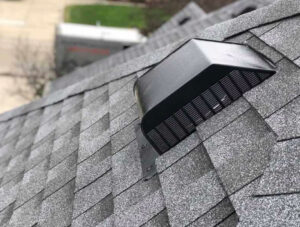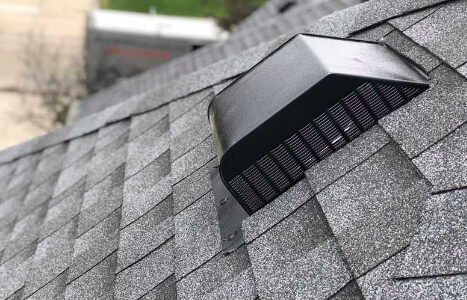Proper roof ventilation is very important to the overall health of your home and its occupants. In addition, consistent airflow keeps the shingles and wood beams in the attic healthy and allows them to last longer. Ventilation is also required by building codes in many areas. It’s designed to remove excess heat from the attic and relieve your air conditioning system strain. Visit Website to learn more about the signs of roof ventilation.
Prevents Ice Dams
 Ice dams are a clear sign that your roof isn’t ventilated properly. These large icicles (and the rotting, water-soaked insulation behind them) can cause serious damage to your gutters and roof, as well as pose a health hazard to people who walk under them. Despite the many myths about ice dams, there is only one true way to prevent them: proper attic ventilation.
Ice dams are a clear sign that your roof isn’t ventilated properly. These large icicles (and the rotting, water-soaked insulation behind them) can cause serious damage to your gutters and roof, as well as pose a health hazard to people who walk under them. Despite the many myths about ice dams, there is only one true way to prevent them: proper attic ventilation.
When a house is poorly ventilated, heat from the living space seeps into the attic and melts snow on the warmer upper sections of the roof. This water runs down to the colder eaves and refreezes, creating an ice dam. Once this dam builds up, it can block the flow of any further melting snow and ice, and may also leak into the ceiling and walls below.
Poor attic insulation and a cluttered attic further contribute to the problem. Insulation that is wet or has a lot of dust on it becomes less effective, and can lose up to 50% of its R-value. The best solution is to re-insulate the attic, and seal air leaks around mechanical units (like HVAC equipment) and ductwork.
Various band-aid solutions have been developed to address the problem of ice dams, including heat cables in a zig-zag pattern along the roof edge. These waste energy, and don’t completely prevent ice dams because the ice they melt simply refreezes on the roof or gutters.
In the end, the only real solution is to properly vent the attic, insulate, and close any air leaks. Then the roof surface will remain constant, and snow won’t melt on the top and freeze as it melts on the bottom.
If you have ice dams, take care of them as soon as possible to minimize the damage they can do. It’s not always possible to eliminate a huge ice dam, but it is easy to keep them from growing larger by removing snow manually or using a ladder and a long-handled roof rake (operated from the ground). Never use a hammer or chisel to remove ice dams, since this can damage your roofing materials.
Cools the Attic
During hot climates, roof ventilation releases solar-heated air from the attic. This cools the living space below and relieves the strain on an air-conditioning system.
Proper ventilation also eliminates moisture in the attic and helps to preserve the wood beams and floorboards in the attic, preventing rot and mildew. Often, when there is no ventilation, moist air sits in the attic for long periods of time. When the sun comes out, the moisture will seep through the ceilings into the living space, and your air conditioner will work harder than it should, driving up your utility bills.
Poor attic ventilation can also cause sagging or curling shingles, as well as dark stains on the eaves or walls. These are signs that it’s time to install or update your ventilation system.
The way that roof vents work is actually quite simple. The basic concept is that hot air rises and, if it has no way out, will create high pressure at the highest points in the attic. When this happens, cooler air from the outside will naturally move in to replace it. Ventilation systems can include gable vents, ridge vents, and shingle vents. They are available in both manual and electric-powered models and can be installed in a variety of ways to best suit the attic’s layout and your home’s design.
In mixed climates, the ventilation system may serve both intake and exhaust functions. In intake mode, the air is pulled through the vents at the eaves, and in exhaust mode, it’s expelled from the vents at the ridge. Gable vents, which can only be used on gable roofs, are typically placed on both sides of the attic, and can be installed parallel to the prevailing winds to optimize their effectiveness. Ridge vents are similar to edge vents, but they are installed at the very peak of the attic, which maximizes their efficiency.
Building codes generally require one square foot of vent area for every 300 square feet of attic space. If there is no vapor barrier in the attic, this should be doubled.
Prevents Mold & Mildew
The presence of mold in an attic is one of the most common signs that there may be a roof venting issue. If left unchecked, mold can spread from the attic to living spaces below. This can cause a musty odor that may be noticeable throughout the home. Mold can also contribute to respiratory problems in occupants. In some cases, the presence of mold has been linked to a variety of health conditions including asthma, sinus infections, and chronic coughing.
Moisture is one of the primary causes of mold and mildew. Mold spores thrive in a humid environment and require a food source, like wood or drywall. When these conditions are met, the spores will grow into new mold colonies that can lead to damage to the ceilings and walls in the house below.
Proper attic ventilation prevents these issues by keeping the attic temperature low and allowing air to flow freely through soffits, vents, and ridge vents. As the air flows, it pulls moisture from ducts and vents as well as from the attic floor itself. This moisture is then carried away from the attic by the constant airflow.
However, if this attic ventilation is inadequate, humidity will build up in the attic space. This moist air can condense on cool surfaces in the attic, such as the sheathing, leading to the growth of mold and rot. In addition, the air that is pushed out of the attic by clogged attic vents can leak into living spaces, contributing to high energy bills and potential structural damage.
While it’s important to clean any mold spores from your home, it is equally important to address the root cause of the problem – inadequate roof ventilation. Regular cleaning and maintenance of your soffits, vents, and roof can help keep your home free from mold, as well as prevent ice dams and other attic issues.
Prevents Damage to the Roof
When a roof is properly ventilated, moisture and hot air that would otherwise be trapped in the attic can escape. This prevents the attic from rising in temperature, which can cause damage to shingles and wood framing. It also prevents the buildup of condensation that leads to mold and mildew. And finally, it helps the shingles last longer and keeps them from cracking or fading in color.
If you have noticed signs of poor roof ventilation, it is important to address them as soon as possible. Some of the most common signs of poor ventilation include:
Icicles & Ice Dams
When you see large icicles forming along the edge of your roof and gutters, it is a sign that the attic is not well-ventilated. This is because warm air in the attic combines with snow to melt it, and then the water freezes when it reaches the edge of the roof. Iccles and ice dams can break gutters, soffits and shingles, and they also can damage the interior of your home.
Unusually High Energy Bills
When your home is not properly ventilated, it can make it difficult for your air conditioning system to keep the house cool. This is because it works harder to compensate for the heat that is escaping through the attic.
To be properly ventilated, your attic needs both intake and exhaust vents that are evenly spaced throughout the attic. When your ventilation system is installed correctly, these vents work together to create a constant flow of air through the attic and out the exhaust vents. A properly balanced venting system will also ensure that there are no hot spots in the attic that can damage your roof and insulation, as well as prevent mold and mildew.
